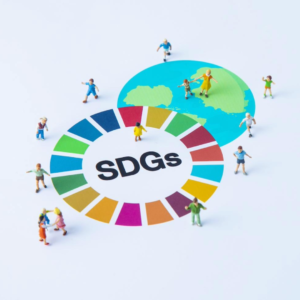Sustainable Business for a Better World
Introduction to Sustainable Development Goals
The Sustainable Development Goals (SDGs) are a set of 17 global goals adopted by all United Nations Member States in 2015 as part of the 2030 Agenda for Sustainable Development. The SDGs provide a shared blueprint for peace and prosperity for people and the planet, now and into the future and lets explore how sustainable businesses can drive sustainable change, aligning with SDGs. A comprehensive guide to implementation, impact, and reporting for corporate responsibility.
The 17 SDGs are:
- No Poverty
- Zero Hunger
- Good Health and Well-Being
- Quality Education
- Gender Equality
- Clean Water and Sanitation
- Affordable and Clean Energy
- Decent Work and Economic Growth
- Industry, Innovation and Infrastructure
- Reduced Inequality
- Sustainable Cities and Communities
- Responsible Consumption and Production
- Climate Action
- Life Below Water
- Life on Land
- Peace, Justice and Strong Institutions
- Partnerships for the Goals
The SDGs cover social and economic development issues including poverty, hunger, health, education, climate change, gender equality, water, sanitation, energy, environment and social justice. The goals interconnect and in order to leave no one behind, itís important that we achieve each goal and target by 2030.
The SDGs are important for both business and society. Companies can align their priorities and strategies with the SDGs to demonstrate their commitment to sustainable development. The SDGs provide a framework for companies to report and improve on their environmental, social and governance (ESG) performance. Achieving the SDGs will create new business opportunities and markets, promote long-term economic growth, and contribute to more sustainable and equitable societies.

SDGs Related to Poverty and Hunger
The first two Sustainable Development Goals focus on ending poverty and hunger around the world. These goals aim to help the most vulnerable populations meet their basic needs.
Sustainable businesses can help achieve SDGs 1 and 2 in several ways:
- Paying employees a fair and livable wage can lift households out of poverty. Companies should ensure compensation aligns with cost of living.
- Donating a portion of proceeds or products to anti-hunger organizations gets food and nutrition to those lacking resources. Partnerships with food banks, soup kitchens, and meal programs enable companies to donate excess food.
- Establishing corporate social responsibility programs to aid impoverished communities improves education, health, and opportunities. These outreach efforts may involve school supplies drives, housing construction projects, or healthcare clinics.
- Offering low-income individuals employment opportunities, training, and advancement prospects empowers them to earn a stable income.
- Advocating for government policies and programs that assist underprivileged populations gives the business community a powerful voice to enact change.
With targeted efforts, the private sector can significantly help end poverty and hunger around the globe. Alleviating these issues improves lives while creating consumer markets to drive economic growth.
SDGs for Health and Wellbeing
The Sustainable Development Goals related to health, wellbeing and education are SDGs 3, 4 and 5. These focus on good health, quality education, and gender equality. Businesses play an important role in supporting these goals through programs and policies for employees and communities.
Some examples of business initiatives for health and wellbeing include:
- Wellness programs – Companies can promote exercise, nutrition, preventative health screenings and access to health services. This improves worker health and reduces healthcare costs.
- Health education – Businesses can provide health education resources to employees to help them make informed lifestyle choices related to diet, exercise, substance abuse, and mental health.
- Flexible work policies – Options like telecommuting, flex time and parental leave support work/life balance and mental wellbeing.
- Employee assistance programs – These provide counseling and support services to workers facing challenges with mental health, addiction, relationships or finances.
For education, companies can provide training programs, tuition assistance and partnerships with schools. Mentorship programs, vocational training and continued learning promote equal opportunity.
Regarding gender equality, Sustainable businesses should have policies against discrimination, harassment and unfair pay gaps. They can support women’s professional development through networking, mentoring and leadership training. Family-friendly policies for both women and men are also important.
Companies that invest in the health, education and wellbeing of their workforce reap rewards in terms of productivity, retention, and employee satisfaction. Supporting these SDGs is beneficial for both business and society.
SDGs for Energy and Infrastructure
A key focus of the SDGs is promoting affordable and clean energy, building sustainable infrastructure, and encouraging innovation. Businesses play an important role in helping achieve these goals (SDGs 7, 9, and 11).
Renewable energy is critical for reducing greenhouse gas emissions and mitigating climate change. Many companies are investing in clean power by installing solar panels, buying renewable energy credits, or signing power purchase agreements for wind and solar energy. Switching to renewable energy for operations supports SDG 7.
Businesses can also design sustainable operations by following green building standards, improving energy efficiency, and reducing waste. Investing in cleaner transportation networks, smart urban planning, and resilient infrastructure aligns with SDG 11.
In addition, companies that dedicate resources to research and development are driving innovations that lead to breakthrough technologies. Developing innovative solutions to pressing global challenges advances SDG 9.
By making investments in renewable energy, optimizing operations, and funding R&D, companies can significantly contribute to targets for affordable clean energy, infrastructure, and innovation. This helps ensure access to modern energy services, upgrades in technology and infrastructure, and sustainable industrialization.
SDGs for Sustainable Production
The SDGs aim to promote sustainable and responsible production and consumption. This involves both optimizing business processes to use resources more efficiently, as well as making supply chains and procurement practices more sustainable.
SDG 12 focuses on ensuring sustainable consumption and production patterns. For businesses, this means improving resource efficiency in manufacturing, reducing waste generation, adopting sustainable practices and green procurement policies, and providing sustainability information to consumers. Companies can analyze production processes to identify inefficiencies, utilize cleaner technologies, reduce toxic materials and emissions, recycle and reuse materials, reduce packaging, and collaborate across industries to find solutions.
SDG 13 aims to take urgent action to combat climate change and its impacts. Businesses contribute to climate change through greenhouse gas emissions, so steps must be taken to reduce carbon footprints by improving energy efficiency, using renewable energy, and reducing emissions. Companies can switch to green power options, optimize transportation and distribution networks, use carbon offsets, and engage in emissions trading schemes.
To fully implement sustainable production, businesses may need to rethink entire value chains. This could involve developing closed-loop production systems, designing products for longevity, maintenance, repair, reuse, refurbishment and recycling. It also requires building resilience against environmental risks across operations and supply chains. Tracking, reporting and communicating sustainability efforts also helps hold businesses accountable.
Sustainable Development Goals for Life Below Water
The oceans cover over 70% of the planet and are a major source of food, oxygen, and biodiversity. However, human activity has put immense pressure on marine ecosystems through overfishing, pollution, acidification, and more. That’s why the UN created Sustainable Development Goal 14 – Life Below Water.
This goal aims to sustainably manage and protect marine and coastal ecosystems. Businesses have an important role to play in achieving this goal. Some examples of business initiatives include:
- Reducing plastic packaging and waste that ends up in the oceans. Companies like Adidas and Dell are using recycled ocean plastic in their products.
- Sourcing seafood sustainably and helping fishing communities transition to sustainable practices. Unilever aims to source all fish from certified sustainable sources by 2020.
- Using cleaner shipping fuels, optimizing shipping routes, and investing in zero emission vessels to reduce pollution. Maersk aims to launch carbon neutral vessels by 2030.
- Partnering with organizations working on mangrove restoration, coral reef protection, and marine conservation areas.
- Investing in circular economy solutions to keep plastics in use and out of the oceans.
- Reporting on ocean-related risks and dependencies, along with reduction targets, as part of sustainability disclosures.
With business creativity, innovation and commitment, significant progress can be made towards healthy and sustainably managed oceans. But continued effort is needed on multiple fronts to truly achieve the SDG 14 vision.
SDGs for Life on Land
The Sustainable Development Goals aim to conserve and sustainably use terrestrial ecosystems. Specifically, SDG 15 focuses on protecting, restoring and promoting sustainable use of terrestrial ecosystems, sustainably managing forests, combating desertification, and halting and reversing land degradation and biodiversity loss.
Sustainable business have an important role to play in achieving this goal. Here are some ways businesses can promote biodiversity and sustainable land use:
- Adopt sustainable agriculture practices such as crop rotation, soil conservation, and integrated pest management. These practices maintain soil fertility and reduce reliance on chemical fertilizers and pesticides.
- Implement responsible sourcing policies for commodities like palm oil, soy, timber, and paper to prevent deforestation. Work with suppliers to source certified sustainable commodities.
- Invest in reforestation efforts by planting trees and partnering with nonprofits focused on reforestation. This helps offset carbon emissions and restores degraded land.
- Preserve biodiversity by avoiding land development in protected areas and regions of high biodiversity value. Conduct environmental impact assessments before major projects.
- Support smallholder farmers by providing training in sustainable practices. Work with industry groups and NGOs to build capacity.
- Report on impacts on biodiversity and land use through sustainability reporting. Set science-based targets for reducing impacts over time.
- Engage in ecosystem restoration projects to revive degraded land and bring back native vegetation and species.
By taking action to conserve terrestrial ecosystems, businesses can significantly contribute to the SDG 15 and build a more sustainable future. Sustainable land management practices are key to protecting biodiversity and natural resources for generations to come.
SDGs for Peace and Partnerships
The SDGs aim to promote just, peaceful and inclusive societies. This involves reducing violence, delivering access to justice for all, combating organized crime and illicit arms flows, reducing corruption and bribery, developing effective institutions, and increasing public access to information.
Businesses play a key role in supporting these goals through ethical business practices, anti-corruption policies, and cross-sector partnerships. Some specific ways businesses can contribute include:
- Implementing ethical codes of conduct for employees
- Providing training on anti-corruption and bribery
- Ensuring transparency in financial reporting
- Partnering with NGOs and other businesses to advance the SDG goals
- Using leverage in supply chains to combat child labor and human trafficking
- Publicly reporting on anti-corruption policies and compliance
- Advocating for protection of fundamental freedoms and human rights
Partnerships between governments, civil society and the private sector are critical for achieving the SDGs. Businesses that embrace ethical practices and collaborate across sectors will be well-positioned to support sustainable development while also enhancing their reputations.
Implementing and Reporting on SDGs
For businesses, implementing programs and strategies related to the SDGs can help drive long-term value creation and sustainable growth. Here are some best practices for businesses looking to effectively implement SDG initiatives:
Strategies for Businesses to Implement SDG Programs
- Conduct an assessment to identify priority SDGs where the business can make the most impact. Consider the company’s operations, supply chain, social impact potential, and more.
- Set concrete goals and key performance indicators for each priority SDG. Track progress over time.
- Communicate to all internal stakeholders how embracing SDGs will benefit the business. Get buy-in from leadership and employees.
- Identify partnership opportunities with nonprofits, NGOs, and other businesses to amplify impact on the SDGs. Collaboration will be key.
- Embed SDGs into business functions like HR, operations, procurement, marketing and communicate consistently on SDG efforts.
- Leverage innovation and technology to create solutions that advance the global goals.
SDG Reporting Frameworks and Best Practices
- Use established ESG and sustainability reporting frameworks like GRI to disclose on SDG performance.
- Focus on material SDGs in sustainability reports and ensure thorough, accurate data collection.
- Get independent external assurance to validate SDG disclosures and build trust.
- Share lessons learned from SDG efforts, not just positive stories. Be transparent about challenges.
- Make SDG reports accessible to all stakeholders, not just investors. Consider creative mediums beyond just written reports.
- Participate in benchmarks like the UN Global Compact to showcase SDG leadership and commitment.
- Use storytelling to make SDG reporting compelling, highlighting real human impact.
- Set ambitious future SDG targets and keep striving for improvement. SDG journey is ongoing.
By strategically implementing and reporting on the SDGs, businesses can drive meaningful progress and system change for the goals while future-proofing their long-term Sustainable business success.
The Future of SDGs
The 17 Sustainable Development Goals (SDGs) adopted by United Nations member states in 2015 aim to address major global challenges related to poverty, inequality, climate, environmental degradation, prosperity, peace, and justice by 2030. Significant progress has been made, but much work remains to fully achieve the SDGs.
With less than a decade left, businesses, governments, and civil society must accelerate efforts and collaborate in new ways to realize the vision of the goals. There are many emerging best practices and innovations that provide hope, including:
- Public-private partnerships to promote renewable energy and clean water access.
- Sustainable supply chain initiatives to eradicate child and forced labor.
- Technology like mobile banking and fintech increasing financial access.
- Collaborative initiatives to restore forests and landscapes.
- Circular economy business models that design out waste.
Achieving the SDGs will require systems change and unprecedented cooperation among all sectors of society. The long-term benefits for business and society are immense: ending extreme poverty, reducing inequality, building climate resilience, reversing environmental degradation, and promoting inclusive societies with access to justice.
Realizing the full potential of the SDGs will result in a more sustainable, equitable, and prosperous world for both current and future generations. The goals provide an essential roadmap and must remain a priority for all in the years ahead. With commitment and ingenuity, a better future is possible.




